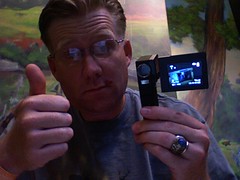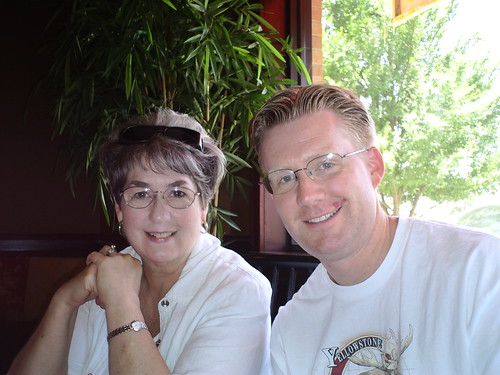Around ten years ago when I first heard Alan November speak at the TCEA conference in Austin, I heard him differentiate between types of classroom technology use. Initially, virtually all teachers use technologies in “accommodating” ways which replicate existing tasks but may make them more efficient thanks to technology. Eventually, he said (as I recall) we want teachers to not just replicate existing learning tasks and activities with technology, but truly engage in TRANSFORMATIVE learning activities which would simply not be possible at all without the use of technologies. Alan called these alternatives “accommodating” uses of technology and “infomating” uses. Infomating uses, in his parlance, are those technology uses which are transformative. These views coincide well with the findings of the 10 year ACOT study, and the stages of technology integration the ACOT researchers identified:
I remain very interested in transformative technology integration ideas as well as transformative technologies. Today our family spent all day with my parents in and around Oklahoma City, and I brought my Sony GC1 Net Sharing Cam with me. Last night and today, I took 24 photos and 12 videos. I am now 100% positive that flash-based video cameras like the GC1 are examples of potentially TRANSFORMATIVE technologies, because they can allow and empower users to do things they simply couldn’t have done without them.
I published these photos and videos right away when we got home this afternoon to both a new password-protected gallery on Mobile Me as well as my Flickr account. Since the GC1 records directly into MP4 format, the videos import directly into iPhoto on my Macbook Pro just as the photos do, and with only a few clicks can be (and now ARE) published to the web. Amazing. My mom asked me why she should consider a Mobile Me account, and in addition to explaining “push calendar” functionality I demonstrated the publishing of these images and videos to the web to her.
Her reaction was that this seems “scary,” because of how easy it is and how it seems our privacy may be non-existant with cameras and recorders like this all around us. I did password protect the entire Mobile Me gallery and password protected all the videos and photos on Flickr that have our kids in them, so ALL privacy is not being given up here… But her points made me recall the “publish at will” language I used in my November 2006 post “IP, the Information Age and YouTube:”
We live in an era where people can PUBLISH AT WILL. Relevance is and will increasingly be a function of digital accessibility. You want to be relevant? Give away your ideas. Want to become irrelevant? Create a walled garden that keeps out more people than it lets in. You’ll be sure to limit your audience, and therefore reduce your relevance and potential impact on the world. Sharing ideas. It’s what the Internet was founded for, and what it is still all about.
I admit I have been a real doubter when it comes to new video camcorder formats. After all, I’ve used tape-based camcorders for years, why on earth should I want a camera that records directly to another format, whether a flash hard drive, a DVD, or another option? The flash-based recorders I saw in the past seemed more like toys than real camcorders, just looking at them “from the outside.” It sounded good to record video directly to a camcorder’s hard drive, but those types of cameras seemed sooooo expensive. Why change camera formats, I thought?
After today’s experiences I can clearly tell you why a video camera format change to flash-based storage can be transformative: Immediate publishing. One of the biggest reasons I don’t publish more video is that it takes so much TIME to edit, compress and publish it. Certainly it is easier to compose a blog post or even create an audio podcast than edit video footage. That is still true relative to EDITING video, but flash-based video recorders like the GC1 make it easier than ever. I think I finally see the rationale and strategic vision behind iMovie ’08. As consumers and learners today and in the future, we are going to be shooting and editing a lot more flash-based video as I did today as a society than we are going to be recording to tape, editing and publishing.
As a specific example of how video saved to tape can be arduous to edit and publish, I still have about 30 minutes of cumulative video to edit into a five minute iMovie from our family vacation to New Mexico the first week of June this summer. Have I created that video and published it? No? Why, you ask? Because that takes a fair amount of TIME. I will do this project, but I haven’t yet.
How about the video from today’s sightseeing, visiting and shopping? It’s all already published on the web, on password protected sites which give me control over who sees and does not see this media content. Behold, the power of flash-based video recording and web publishing!
I was glad, incidentally, to find and use a preview release of Flickr’s uploadr 3.1 which (for the first time) supports the uploading of video files as well as photos. It worked flawlessly and allowed me to simultaneously upload 12 different, short MP4 video clips to my Flickr account.
I am THRILLED to have found this Sony GC1 camcorder and camera for $50 last weekend. WOW. This is truly a powerful tool for those who desire to “publish at will” and include video in their publication vitae. 🙂
Technorati Tags:
publish, technology, video, flash, flickr, mobileme
If you enjoyed this post and found it useful, subscribe to Wes’ free newsletter. Check out Wes’ video tutorial library, “Playing with Media.” Information about more ways to learn with Dr. Wesley Fryer are available on wesfryer.com/after.
On this day..
- Creatively Saying with Video: Grandchild #10 is Coming! – 2011
- How important are these digital skills for you as an educator? (poll) – 2010
- links for 2008-07-26 – 2008
- WordPress 2.6 up and running – 2008
- Let’s work together, shall we?! – 2007
- A digital playground of dreams? – 2007
- Podguides and virtual field trips – 2006
- Track MTI 2006! – 2006
- Prescriptions for 21st Century Intentional Living – 2005
- Living in an Attention Economy – 2005




Comments
9 responses to “Transformative power of flash-based video cameras”
What I struggle with is how much will easy video publishing contribute to lazy and uninspired work? I realize that this already exists with writing but I can’t help but think that because of the work involved in creating good video, if this doesn’t create a greater divide?
I’m still trying to figure out how we can better distinguish between various forms of video and even categorizing work as “in draft” or “unedited”.
http://ideasandthoughts.org/2008/01/05/what-is-video/
I think too often we can easily lump it all together. That’s going to be a real challenge for educators.
My students don’t want to take my ‘old’ tape DV cams out unless they’re doing something major. They use their phones and miss a lot. I am really going to think about this. Thanks for the care, the links, and providing the impetus.
Wes:
I am currently negotiating with an ebay seller to acquire a Sony GC1, with all of the cables for around $80.00 shipped to me. I think that what I have seen here it is going to be the right camera to use for UStreamTV for my classes this year.
I just recorded my first UstreamTV “show” today: http://tinyurl.com/5uaxq3 I think that I will be able to use it this year for a lot of different things when I start encouraging my students to start their own digital stories.
I do have a question for you concerning microphones. I remember at NECC you appeared to have an additional microphone when you made your presentation. I am concerned that the microphone in the GC1 will not be that great if you are in a large classroom away from the camera while the recording is taking place. Could you make a recommendation?
At some point you need to review the Flip Video Camera I bought one in April and have used it quite a bit over the summer. It sure is easy to work with and to publish to YouTube with.
John: I have not gotten the GC1 to work with Ustream yet, but I haven’t tried on a Windows computer, just a mac. The mac does not seem to recognize it as a USB webcam. It may be possible to use it that way with some special driver software installed, macam might work but I haven’t tried it. The GC1 does have a streaming mode that you can set in the menus…
As far as the external mic, at NECC I used my Olympus WS-110 and iRiver to record, but neither was attached to my computer for Ustream purposes. I think ideally a wireless lapel mic would be great, but when you start using wireless mics that certainly adds a layer of complexity as well as batteries you have to worry about.
I certainly would like to review the Flip. I haven’t played with one of those yet at all.
Good luck and please keep me posted on how things go with your webstreaming work.
[…] read a recent post of Wes Fryer’s recently about the the transformative power of flash-based video cameras. It made me think about teacher uptake of technology on a much broader scale, especially with […]
[…] transformative-power-of-flash-based-video-cameras/ blogpost about flash based video cameras (tags: blogpost videos) […]
This is an exciting way to teach…
[…] to my flash-based video camcorder and Flickr’s relatively recent capability to support 90 second video flash transcoding and […]
[…] lot, just outside the Oklahoma Regional Training Institute here in Oklahoma City. I took these with my Sony GC1 Net Sharing Cam and posted them to a Flickr set for […]